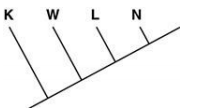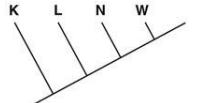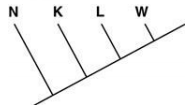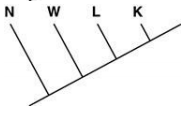
Evolution Review
Quiz
•
Biology
•
9th - 12th Grade
•
Practice Problem
•
Hard

Erin Khouma
Used 50+ times
FREE Resource
Enhance your content in a minute
30 questions
Show all answers
1.
MULTIPLE CHOICE QUESTION
30 sec • 1 pt

Genetic data suggest many frog species that live in Madagascar and India share a common ancestor that lived on the India-Madagascar landmass.
Which statement BEST describes the divergence of frog species found in India and Madagascar?
Breeding preferences of the frogs prevented interbreeding between frogs, resulting in new species.
Geographic separation led to divergence in the gene pool, resulting in a new species in each location.
The frog species occupied different habitats within the same geographic areas, resulting in new species.
Different mating seasons led to the divergence of the gene pool, resulting in a new species at each location.
2.
MULTIPLE CHOICE QUESTION
30 sec • 1 pt

Students were asked to identify the following birds using the classification key shown.
Which statement correctly identifies two of the birds?
Bird 1 is a Ruby-throated hummingbird and Bird 2 is a Tufted titmouse.
Bird 2 is a Great blue heron and Bird 3 is an Ovenbird.
Bird 2 is a Red-tailed hawk and Bird 3 is a Killdeer.
Bird 1 is an Ovenbird and Bird 3 is a Tufted titmouse.
3.
MULTIPLE CHOICE QUESTION
30 sec • 1 pt
A river changes course so a population of mice is subdivided into two populations. The forest on the eastern side of the stream contains a land predator that is absent on the western side of the stream. Which outcome will MOST likely occur in the mice populations over many generations?
Mice on the western side of the stream will have better camouflage.
Mice on the eastern side of the stream will have a different number of chromosomes.
The two groups of mice will develop different adaptations.
The two groups of mice will continue to eat the same food.
4.
MULTIPLE CHOICE QUESTION
30 sec • 1 pt

The data table below shows the percent differences in the DNA of four species.
Based on the data in the table, which cladogram is most accurate?




5.
MULTIPLE CHOICE QUESTION
30 sec • 1 pt

A scientist sees the organism shown below in an aquarium and uses a key to help classify the species.
Based on the key above, what species did the scientist observe?
spotted moray eel
spotted eagle ray
glassy sweeper
glasseye snapper
6.
MULTIPLE CHOICE QUESTION
30 sec • 1 pt
Drought affects a population of plants. One specific plant’s growth rate slows in response to the drought. How could the drought-resistant trait become more common in the population?
Other plants will begin to produce drought-resistant seeds.
The drought-resistant plant will convey its traits to nearby plants.
Other plant species will cross-pollinate with the drought-resistant plant.
The drought-resistant plant will produce more seeds than the other plants.
7.
MULTIPLE CHOICE QUESTION
30 sec • 1 pt

The drawing shows a dark-colored peppered moth and a light-colored peppered moth.
The increased use of coal in 19th-century England lead to the coating of the landscape with black coal dust. The event coincided with a change in peppered moth populations. Over time, the frequency of dark-colored moths became greater than that of light-colored moths. What was the advantage of the dark-colored moths over the light-colored moths?
The dark color allowed them to successfully migrate.
The dark color helped them to successfully catch prey.
The dark color increased their ability to hide from predators.
The dark color prevented coal dust from harming their wings.
Create a free account and access millions of resources
Create resources
Host any resource
Get auto-graded reports

Continue with Google

Continue with Email

Continue with Classlink

Continue with Clever
or continue with

Microsoft
%20(1).png)
Apple
Others
Already have an account?
Similar Resources on Wayground

25 questions
Virtual exam 3rd grade elementary
Quiz
•
1st - 12th Grade

25 questions
Energy Transfers Practice
Quiz
•
9th - 12th Grade

25 questions
Respiration in organisms
Quiz
•
7th Grade - University

25 questions
Heart Arteries and Veins
Quiz
•
11th Grade

25 questions
Reabsorption and Secretion
Quiz
•
12th Grade

25 questions
Chondrichthyes: Cartilaginous Fish
Quiz
•
12th Grade - University

25 questions
Nutrition in Plants
Quiz
•
12th Grade

27 questions
Autonomic Nervous System
Quiz
•
11th - 12th Grade
Popular Resources on Wayground

25 questions
Multiplication Facts
Quiz
•
5th Grade

15 questions
4:3 Model Multiplication of Decimals by Whole Numbers
Quiz
•
5th Grade

10 questions
The Best Christmas Pageant Ever Chapters 1 & 2
Quiz
•
4th Grade

12 questions
Unit 4 Review Day
Quiz
•
3rd Grade

20 questions
Christmas Trivia
Quiz
•
6th - 8th Grade

18 questions
Kids Christmas Trivia
Quiz
•
KG - 5th Grade

14 questions
Christmas Trivia
Quiz
•
5th Grade

15 questions
Solving Equations with Variables on Both Sides Review
Quiz
•
8th Grade
Discover more resources for Biology

20 questions
Cell organelles and functions
Quiz
•
10th Grade

20 questions
Punnett Squares and Genetics
Quiz
•
9th Grade

25 questions
photosynthesis and cellular respiration
Quiz
•
9th Grade

20 questions
Stages of Meiosis
Quiz
•
9th - 12th Grade

20 questions
DNA & Protein Synthesis
Quiz
•
9th Grade

25 questions
The Cell Cycle and Mitosis
Quiz
•
9th Grade

20 questions
23 Protein Synthesis Review
Quiz
•
9th Grade

20 questions
AP Biology: Unit 3 Review (CED)
Quiz
•
9th - 12th Grade
